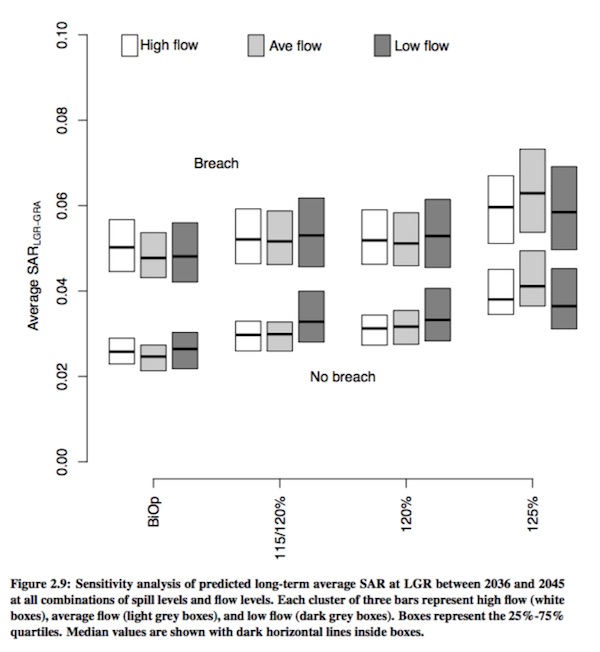forum
library
tutorial
contact

Snake River Dam Removal Questions
Dominate Columbia River Draft EIS Webinar
by K.C. Mehaffey
NW Fishletter, June 4, 2018
|
the film forum library tutorial contact |

|
Snake River Dam Removal Questions
by K.C. Mehaffey
|
She said the alternatives will also include a very detailed socioeconomic analysis,
including the impacts to tourism and navigation if dams are breached.
 Questions about removing the Snake River dams dominated a May 30 webinar hosted by federal action agencies updating the public on their progress in developing an environmental impact statement (EIS) for Columbia River System Operations.
Questions about removing the Snake River dams dominated a May 30 webinar hosted by federal action agencies updating the public on their progress in developing an environmental impact statement (EIS) for Columbia River System Operations.
Some 110 people attended by phone or online a presentation on how the Bonneville Power Administration, the U.S. Army Corps of Engineers and the Bureau of Reclamation are working toward a draft EIS to mitigate for 14 federal dams and reservoir projects in the Columbia River Basin while meeting the multiple purposes authorized by Congress. The half-hour presentation was followed by an hour of questions and answers.
The agencies expect to issue a draft EIS by March 2020, and a final EIS with a preferred alternative a year later.
Lydia Grimm, a senior policy advisor at BPA, said Congress authorized the Corps to construct, operate and maintain the projects to meet multiple purposes, including flood risk management, navigation, hydropower production, irrigation, fish and wildlife conservation, recreation, municipal and industrial water supply, and water quality. BPA is authorized to market and transmit the power generated by them.
Grimm said the agencies are in the heart of the analysis process after developing single alternatives--each focusing on a targeted objective--that are being used to build the multiple-objective alternatives.
For example, she said, a single-objective alternative focused on fish passage and survival would include several possible actions with various levels of spill, different actions to improve adult, juvenile and resident fish survival, along with breaching the lower Snake River dams. The agencies are using measures from those single-objective alternatives to develop a range of multi-objective alternatives, including a no-action alternative, Grimm said.
Next, they will look at the different alternatives and evaluate impacts, and begin to compare them in terms of effectiveness, she said. The agencies will add mitigation measures to account for impacts, and weigh them with respect to their effectiveness under different climate change scenarios, she said.
Most of the questions following Grimm's presentation related to how the agencies will include removing the four lower Snake River dams in their analysis. Rebecca Weiss, the Corps' program manager for the CRSO EIS, noted more than once that while removing the dams is being analyzed, her agency cannot take that action without authorization and funding from Congress.
Weiss also said that a 2002 analysis of breaching these dams will not be used because it is outdated, and many things have changed or have been learned about dam removal since then. She said the agencies are looking at a "controlled breach," rather than a hydrologic breach option to allow the river to rebound, and so other infrastructure is not torn up.
Also in response to questions, Weiss said the agencies cannot put the dams in a "non-operational" status because that would not only discontinue hydro generation, but also fish passage, locks for navigation, and other mitigation and operational measures that are both authorized and expected by Congress. She said the alternatives will also include a very detailed socioeconomic analysis, including the impacts to tourism and navigation if dams are breached.
Regarding lower Snake River hatcheries and dam removal, Weiss said the agencies are looking at how they relate to removing the four dams, and whether, under a dam-removal scenario, the hatcheries would no longer be needed or funded. "It gets very complicated," she said. "You've got mitigation for something you've removed," so the agencies may also have to look at impacts from the loss of mitigation measures, such as hatcheries, she said.
Asked for more details about how they'll incorporate climate change in the analysis, Dave Goodman, a BPA environmental protection specialist, told participants the agencies will be taking examples from a broad range of presumed hydrologic changes from climate-change modeling and applying those to their range of alternatives.
These will help agencies understand what changes they can anticipate, and how each of the alternatives would be impacted under different climate-change scenarios, he said. They will then include mitigation measures for those potential changes in climate. "It's definitely part of the process we've heard loud and clear we need to address," Goodman added.
As for how to address possible changes in the Columbia River Treaty, Weiss said that the analysis has to assume current operations, under the existing treaty, and cannot speculate about what operational changes may occur if the treaty is renegotiated.
The agencies said they expect to provide another update this fall.
learn more on topics covered in the film
see the video
read the script
learn the songs
discussion forum
